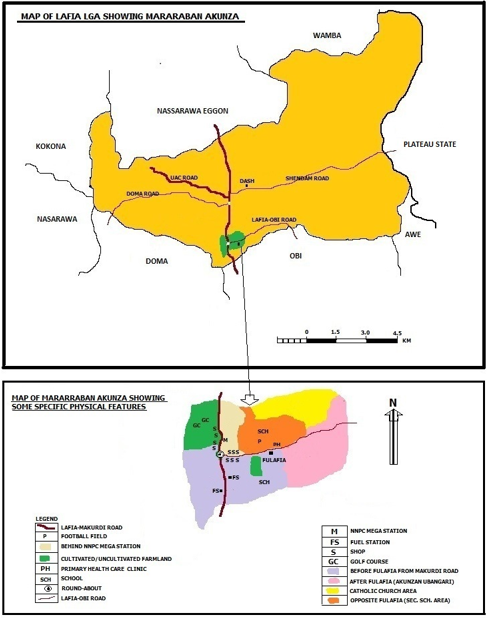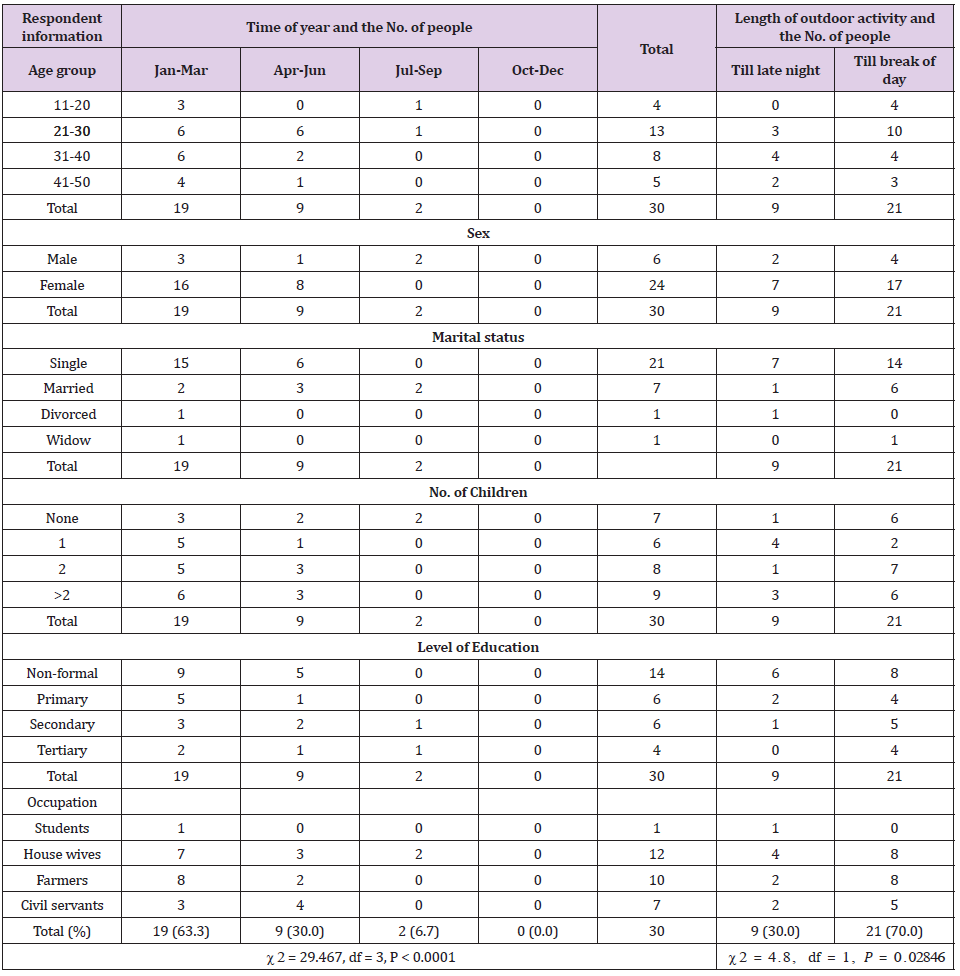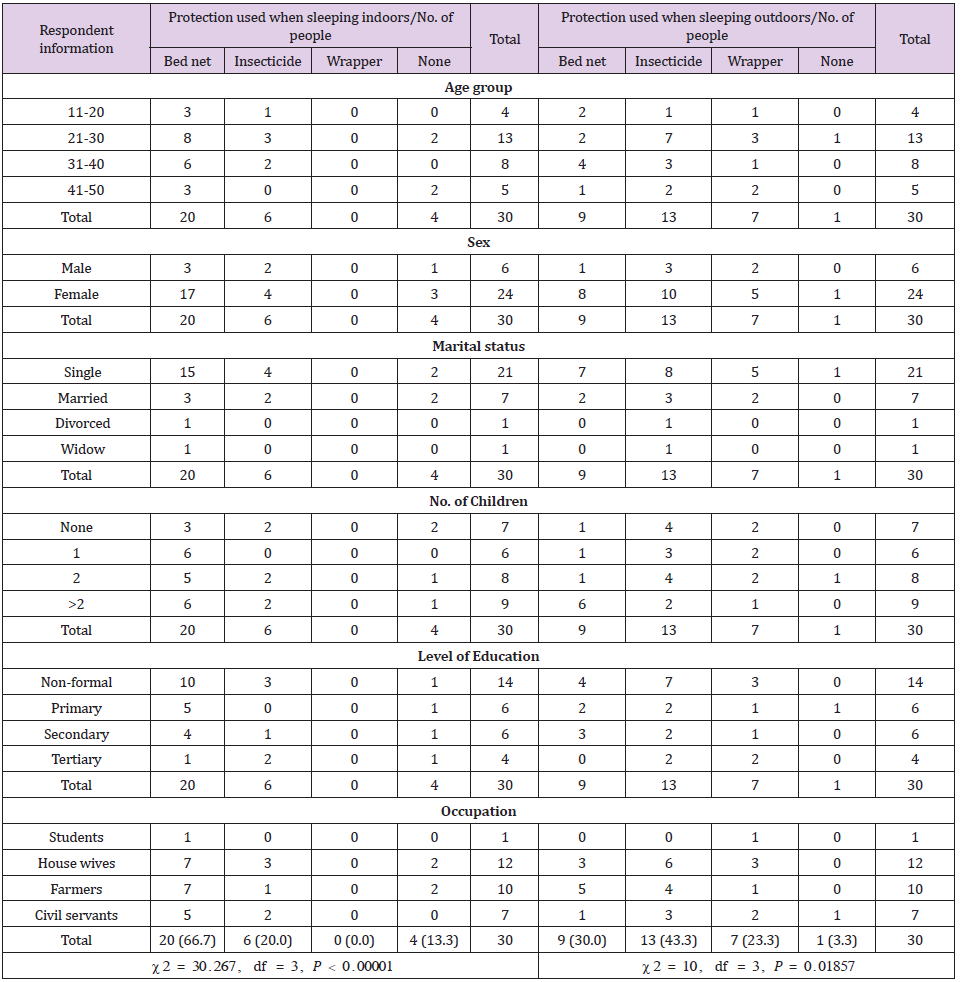Nocturnal Activities and Strategies for Self-Protection Against Human-Vectors Contact in a Peri-Urban Community in Lafia, Nasarawa State, Nigeria
Introduction
Mosquitoes are found in almost the entire globe [1] but are important vectors of several human diseases in tropical and subtropical regions of Africa [2,3]. The warmer climates in tropical areas allow mosquitoes to be active all year round, with the ideal conditions being hot and humid with moderate rainfall. In hot climates they are able to be more active, and the rainfall gives the mosquitoes aquatic sites for larval and pupal stages [1]. Mosquitoes are amongst the anthropophagic insects because they feed on human blood [4,5]. Mosquitoes are found in urban, peri-urban, and rural areas [6 - 9]. Deteriorating infrastructure, poor access to health, water and sanitation services, increasing population density, and widespread poverty contribute to conditions that modify the environment, which directly influences the risk of disease within the urban, peri-urban and rural ecosystem [10,11]. Mosquito vector species that have been shown to be favored by anthropogenic environmental change include Anopheles gambiae which transmits malaria parasite [12,13], Anopheles darlingi [14], and Culex nigripalpus which transmits Wucheraria bancrofti [15], and Aedes aegypti which transmits yellow fever virus [12,13].
Babamale et al. [16] opined that 96% of his respondents recognized mosquito as major transmitter of infections but only 22.6% had adequate knowledge of the correct transmission route. Only 13.2% mentioned Plasmodium species as the causative agent. The knowledge about the ecology of mosquito was greatly applauded in the study area. Health-seeking behaviours and possession of insecticidal treated bet net were found to be associated with socioeconomic status of individuals. The study by Oyewole et al. [17] showed that 13.8% of people in a Nigerian urban center cover cloth against mosquito bite followed by those who make use of mosquito repellant/insecticides spray 39 (9.8%) then door and window screening 37 (9.2%) while very few sleeps under net 17 (4.2%). A negligible proportion support environmental hygiene 26 (6.5%) as a means in which malaria transmission can be prevented.
Similarly, Celina et al. [18] reported that 48% of respondents in fourteen communities in Benue State had knowledge that malaria is caused by mosquito bite. Also, 20.7% attributed the cause of malaria to bad water and dirty water. Furthermore, 6.4% responded that malaria is caused by witchcraft. A total of 82.1% respondents had the knowledge that the best preventive practice is sleeping under nets followed by spraying insecticides (81%) then screening of windows with net (80%) which is also similar to report by Amaechi and Ukpai [19] and Eugene-Ezebilo [20]. An investigation by Msugh-Ter et al. [21] revealed that most students make use of window nets as protection against mosquito bites 77.7% (233/300) followed by insecticide treated nets and insecticidal sprays while very few respondents 0.7% (2/300) made use of mosquito weeds as repellents. The use of at least one form of control measure or the other is an indicator of high rate of mosquito’s bites in the University community.
According to Pam et al. [11], the first quarter of the year (January - March) was the period in which most inhabitants of a community in the lowland area of north-central Nigeria sleep outside, the night activity that a predominant number of the respondents do is just to spend time sitting outside the compound. Most of them sleep outside until it gets cold but not without covering themselves with a blanket and a few sleeps under insecticide treated nets. Although the inhabitants who sleep indoors mostly used insecticide treated nets as form of protection against contact with mosquito. A high proportion of individuals who responded to Pam et al. [11] in relation to being involved in night activities before going to bed said that they use protective covering while staying out at night. Others protect themselves when carrying out night activities by either warding off the mosquitoes or use repellants. Interestingly, a few individuals don’t worry themselves about mosquitos’ bites and some others don’t feel the bites.
The Mararraba-Akunza peri-urban settlement is a mix population which constitutes the sole inhabitants of the area and students of Federal University of Lafia that are probably not aware of the diverse mosquito species present in their locality and the health implication if beaten by an infected one. Also, there is no documented information on peri-urban dwellers nocturnal activities and strategies for self-protection against human-vector contact by households in Mararraba-Akunza, Lafia, Nasarawa State, Nigeria. Hence, the need for this study in order to contribute meaningfully to preventive and integrated control measures.
Materials and Methods
Study Site
The study was conducted in Mararraba-Akunza, with the coordinates 8°28’11.6004” N - 8°28’25.3524” S and 8°35’3.8364” E - 8°34’48.774” W in Lafia Local Government Area of Nasarawa State, Nigeria (Figure 1). Average temperature is about 26.8°C, humidity is relatively high, and rainfall is 456mm [22]. The site is a peri-urban settlement where agricultural activities take place.
Figure 1: Map of Lafia LGA showing Mararraba-Akunza area and map of Mararraba-Akunza area showing some specific physical features.
Ethical Consent
The Chief, elders and heads of households in Mararraba- Akunza community were visited and adequately informed on the importance of the research. Thereafter, the Chief and the households’ heads consented and granted permission for the research to be carried out by endorsing the ethical consent form.
Questionnaire Administration
Questionnaire Administration A well-structured questionnaire was administered to a total of 30 randomly selected households in December 2016.
Statistical Analysis
Data obtained were analyzed using R Console version 2.9.2. Pearson’s Chi-square test was used to compare proportions on the ways and attitude humans control mosquito bites in relation to sleeping points, main outdoor activities at night, the period they sleep in the open, length of stay outdoor as well as the forms of selfprotection for the following categories: age group, occupation, level of education, marital status and number of children. The level of significance was set at P < 0.05.
Results
Sleeping Points of Peri-Urban Dwellers of Mararraba- Akunza Area During Hot Months as well as their Forms of Protection at Outdoor Point
The result obtained showed that the number of males and females that sleep outdoors in hot months was 83.3% and 62.5% respectively as shown in Table 1. The overall number of people that sleep outdoors in hot months were more (66.7%) than those that do not (33.3%). Thus, there was a high significant difference (χ2 = 11.156, df = 1, P = 0.0008378, Table 1) between the number of people that sleep outdoors in hot months to those that don’t.
Also, a 100.0% of males and 95.8% of females use a form of protection against mosquito bite outdoor. The pool number of people that use a form of protection outdoor was 96.7% whereas only 3.3% don’t have any form of protection (Table 1). Hence, there was a very high significant difference (χ2 = 87.236, df = 1, P < 0.00001) between the number of people that use a form of protection outdoors to those that don’t.
Table 1:Number of People that Sleep Outdoors in Hot Months and those that use form of Protection Outdoors in Mararraba- Akunza, Lafia, Nasarawa State, Nigeria.
Main Outdoor Activities at Night
Table 2 shows that the main outdoor activity that predisposes the people to mosquito’s bite was watching television (50%) followed by just staying outside (46.7%) then socializing with friends (3.3%) while none of them was involved in drinking outdoor. Therefore, there was a high significant difference (χ2 = 26.267, df = 3, P < 0.01) in relation to outdoor activities that predisposes people to mosquito’s bite.
The Attitude of the People in Relation to Months (Quarterly Period) they Sleep in the Open as well as the Length of Outdoor Activity
The time of the year that inhabitants of the area mostly sleep outdoors are the months of January to March 19 (63.3%), followed by April to June 9 (30.0%), then July to September 2 (6.7%) and no one sleeps outdoor between October and December 0 (0.0%) as shown in Table 3. Thus, there was a very high significant difference (χ2 = 29.467, df = 3, P < 0.0001) in relation to the months people sleep outdoors. Also, their preference for length of outdoor activity is to stay till day break 21 (70.0%) than till late night 9 (30.0%) hours (Table 3). Hence, there was a significant difference (χ2 = 4.8, df = 1, P = 0.02846) between respondents’ preference in relation to length of outdoor activities.
Table 3: Months people of the peri-urban area sleep in the open as well as length of outdoor activity.
Ways of Self-Protection Indoors and Outdoors from Mosquitoes Bites
Table 4 shows that the most common way of self-protection in the indoor point against mosquitos’ bites was the use of bed nets 20 (66.7%) followed by those who use insecticide 6 (20.0%) while those that don’t use any form of protection were a few 4 (13.3%) and interestingly wrapper was not used by anyone as a form of protection indoors. Therefore, there was a very high significant difference (χ2 = 30.267, df = 3, P < 0.00001) in relation to the ways of self-protections by the people indoors. The protection used outdoors was mostly insecticide 13 (43.3%) followed by the use of bed nets 9 (30.0%) then those who use wrapper 7 (23.3%) while only 1 (3.3%) individual had no form of self-protection against mosquitoes bite (Table 4). Hence, the ways of self-protection outdoors by the people showed a significant difference (χ2 = 10, df = 3, P = 0.01857).
Discussion
The predominant number of males that sleep outdoor in Mararraba-Akunza connotes their high predisposal chances to mosquitos’ bites which may in turn counter interventions deployed as well as decrease manpower in farming activities in the area if such individuals eventually fall ill. This agrees with the finding of Pam et al. [11] who found that males were much more outdoor beyond 9:00 pm than females in Dokan-Tofa community in Shendam LGA of Plateau State, Nigeria. The pooled observed proportion of people that sleep outdoor at one time or the other as a habit during hot months was higher (66.7%) than those that do not sleep outside (33.3%) signifies the possibility of such population being susceptible to residual transmission of mosquito-borne diseases whenever there are suitable infected vectors for such transmission. This is in accordance with the finding by Monroe et al. [23] who observed that nearly all participants interviewed in northern Ghana sleep outdoors and are active. Similarly, Pam et al. [11] showed that over 60% of the interviewees in Dokan Tofa district, Shendam Local Government Area of Plateau State, North-Central Nigeria sleep outdoors. Consequently, Okumu et al. [24] opined that outdoor sleeping can be a major challenge to the control and eventual eradication of mosquitoes-borne diseases, most especially in tropical Africa.
Almost all (96.67%) the respondents protect themselves whenever they sleep outdoors which may limit mosquito-borne disease transmission risk. This is in line with the finding of Suchithra [25] in a study on determining the knowledge and practice regarding prevention of mosquito-borne disease among adult population in Athuru rural community in India who found out that 61% of the population showed good practice preventive measures against mosquitoes bites.
Main Outdoor Activities at Night
The main outdoor activity that exposes people to mosquito bite is watching television followed by just staying outside and no respondent was involved in drinking outdoor. This do not concur with Pam et al. [11] observed that most individuals spend time just sitting outside in their compounds as the main outdoor activity. Most males (66.67%) just stay out (hang out) while the females (54.17%) spent more time watching TV. This is in tandem with Pam et al. [11] who found a significant association between gender and staying outdoor beyond 9 pm by males. The highest proportions of outdoor activities at night were the watching of TV by age group 41- 50 years (60%) and students (100%) respectively. On the contrary, Pam et al. [11] revealed that inhabitants of Dokan-Tofa community of Shendam LGA in Plateau State of ages 21-31 years had the highest likelihood for staying out late while carrying out nighttime activities. Furthermore, Pam et al. [11] showed that occupation do not have significant influence in causing individuals stay outdoors late.
The Attitude of People in Relation to Months they Sleep in the open and Length of Outdoor Activity
The time of the year that inhabitants of the area mostly sleep outdoors are the months of January to March 19 (63.3%), followed by April to June 9 (30.0%), then July to September 2 (6.7%) and no one sleeps outdoor between October and December 0 (0.0%) as shown in Table 3. This is the time when environmental temperatures are accentuated just before the onset and during the early part of rainy season. The single, divorced and widow sleep in the open between January to march with the exception of the married respondents. This is in line with the finding of Pam et al. [11] who reported that the months of January and March witnesses the highest number of outdoor sleepers. A significant number prefer to stay till daybreak 21 (70.0%) than till late night 9 (30.0%). On the other hand, Pam et al. [11] recorded that a higher proportion of individuals (69.0%) slept until it gets cold.
Ways of Self-Protection Indoors/Outdoors from Mosquitoes Bites
The protection mostly used against mosquitos’ bites at the indoor point amongst the peri-urban dwellers of Mararraba-Akunza community is bed nets 20 (66.7%) but does not directly translate to using nets when sleeping outdoors at night due to the fact that they mostly use insecticide 13 (43.33%) much more over other protection measures. This corresponds with the study in Shendam LGA of Plateau State where it was observed that most inhabitants of Doka-Tofa community use insecticide-treated nets against contact with mosquitoes while sleeping indoors whereas at outdoor point they predominantly protect themselves from having contact with mosquitoes by covering up with blankets [11]. Consequently, the large-scale use of insecticide treated nets can modify feeding behavior thereby increasing exophagy in mosquito vectors [26]. There are those that ignore mosquitoes 1 (3.33%) or do not even feel their nuisance in the study area. Thus, this group are the most vulnerable to mosquito bite, and most exposed to diseases such as malaria. When most people are fast asleep at night are beaten by mosquitoes, whose population during the dry season is actually low [27,28] but have the capacity to transmit mosquito-borne diseases if they have bitten an infected individual.
Conclusion
The peri-urban inhabitants of Mararraba-akunza prefer to sleep outdoor during the hot months between January and March. Almost all respondents when resting outdoors use a form of protection against mosquito bite with the exception very negligible proportion that don’t protect themselves. The main outdoor activity that predisposes the people to mosquitos’ bites was watching television. Almost all respondents sleep till daybreak and majority of them use insecticide outdoors but when indoors they sleep under LLINs. The outdoor nocturnal activities of people in the study community will continually expose them to mosquito vectors bites due to high temperature and relative humidity that favours mosquitoes breeding success in lowland areas in which provision of stable power supply in peri-urban areas of Lafia metropolis will go a long way to minimize inhabitants’ outdoor stay and activities. Also, the government through Federal and State Ministries of Health as well as non-governmental organizations (NGOs) should make LLINs available all year round to peri-urban dwellers who constitutes very high population density in order for them to protect themselves both indoors and outdoors.
For more Articles on : https://biomedres01.blogspot.com/







No comments:
Post a Comment
Note: Only a member of this blog may post a comment.